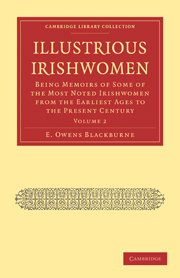 Illustrious Irishwomen
Illustrious Irishwomen Published online by Cambridge University Press: 07 September 2011
maria gunning.
born a.d. 1733. died a.d. 1761.
elizabeth gunning.
born a.d. 1734. died a.d. 1790
MAY the luck of the Gunnings attend you!” was the blessing of an Irish beggar-man in Dublin; and so apposite was the ejaculation that it passed into a proverb. Their social career was as rapid and as brilliant as extraordinary. They came to London in 1750, and by their beauty at once took society by storm. Their intrigues supplied Horace Walpole and the charming Berrys with plenty of food for gossip; one cannot help fancying there is a touch of contemptuous spite in the way in which Miss Berry speaks of them—just that spice of feminine jealousy which gives a piquancy to her letters:—“They have an idea that Lord Blandford is to marry Miss Gunning—an idea so improbable that even the luck of the Gunnings cannot make one believe it.” But the beautiful Irish girls did even better than that in the matrimonial market, for they were “Countessed and double-Duchessed.”
Well-born and of surpassing loveliness, only equalled by their poverty, Maria and Elizabeth Gunning were the daughters of John Gunning, Esq., of Castle Coote, County Roscommon, and of Bridget, daughter of Theobald Burke, sixth Viscount Mayo. An Irish gentleman of the rollicking duelling old school, Mr. Gunning died about the year 1747, leaving his widow and two daughters quite unprovided for. The estate of Castle Coote was deeply burdened with debt, so that immediately upon the death of her husband Mrs. Gunning was obliged to leave the place.
To save this book to your Kindle, first ensure no-reply@cambridge.org is added to your Approved Personal Document E-mail List under your Personal Document Settings on the Manage Your Content and Devices page of your Amazon account. Then enter the ‘name’ part of your Kindle email address below. Find out more about saving to your Kindle.
Note you can select to save to either the @free.kindle.com or @kindle.com variations. ‘@free.kindle.com’ emails are free but can only be saved to your device when it is connected to wi-fi. ‘@kindle.com’ emails can be delivered even when you are not connected to wi-fi, but note that service fees apply.
Find out more about the Kindle Personal Document Service.
To save content items to your account, please confirm that you agree to abide by our usage policies. If this is the first time you use this feature, you will be asked to authorise Cambridge Core to connect with your account. Find out more about saving content to Dropbox.
To save content items to your account, please confirm that you agree to abide by our usage policies. If this is the first time you use this feature, you will be asked to authorise Cambridge Core to connect with your account. Find out more about saving content to Google Drive.